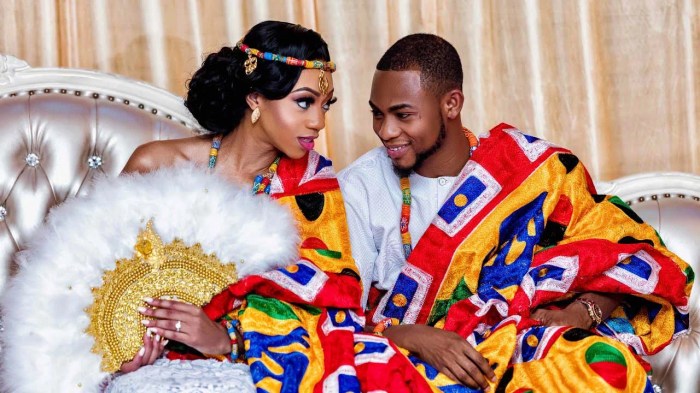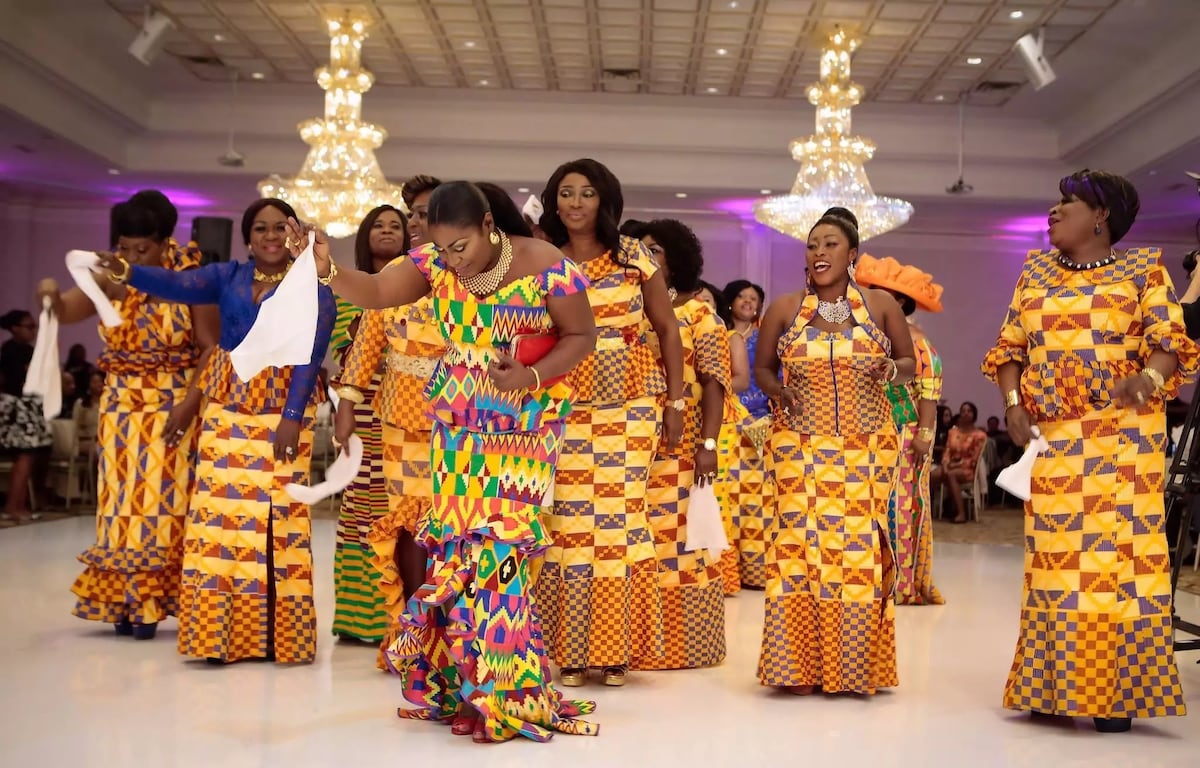Traditional Ghana Wedding Dress A Cultural Tapestry
A Journey Through Ghanaian Wedding Attire
Traditional ghana wedding dress – Ghanaian wedding dresses are vibrant expressions of rich cultural heritage, reflecting centuries of tradition and artistry. The intricate designs, diverse fabrics, and symbolic embellishments tell a story of lineage, social status, and the enduring spirit of Ghanaian communities. This exploration delves into the history, evolution, and regional variations of these captivating garments, showcasing their enduring significance in modern Ghana.
Historical Influences on Ghanaian Wedding Attire
Ghanaian wedding attire boasts a rich tapestry woven from diverse historical threads. Pre-colonial traditions heavily influenced early wedding attire, with garments reflecting the distinct styles and customs of various ethnic groups. The arrival of European traders introduced new fabrics and design elements, subtly altering existing styles. However, the core elements of Ghanaian design – vibrant colors, intricate patterns, and symbolic adornments – remained largely intact, adapting and evolving over time rather than being entirely replaced.
The Evolution of Kente Cloth in Wedding Ceremonies
Kente cloth, arguably the most iconic Ghanaian fabric, holds a prominent place in wedding ceremonies. Originally associated with royalty and high status, its use in weddings signifies celebration and respect. Over time, the designs and weaving techniques of kente have evolved, reflecting changing social norms and artistic influences. While traditional motifs remain central, contemporary designers often incorporate modern interpretations, maintaining the fabric’s cultural significance while adapting it to contemporary tastes.
Significance of Colors and Patterns in Traditional Ghanaian Wedding Dresses
Colors and patterns in Ghanaian wedding attire are far from arbitrary; they convey profound cultural meanings. For example, gold often symbolizes wealth and royalty, while red signifies passion and fertility. Specific patterns may represent family lineage, clan affiliation, or even historical events. Understanding these symbolic elements adds another layer of appreciation to the beauty and complexity of these garments.
Comparison of Wedding Dress Styles Across Ghanaian Ethnic Groups, Traditional ghana wedding dress
Ghana’s diverse ethnic groups each possess unique wedding attire styles. The Ashanti, for instance, are known for their elaborate kente cloth ensembles, while the Ewe may incorporate distinct beadwork and head wraps. These variations highlight the rich tapestry of Ghanaian culture, with each style reflecting the specific traditions and customs of its associated group. Even within a single ethnic group, regional differences can lead to subtle variations in design and embellishment.
Timeline of Key Changes in Ghanaian Wedding Dress Design
A timeline illustrating the evolution of Ghanaian wedding dress design would showcase the gradual shifts over the past century. Early 20th-century attire might have been simpler, with less elaborate designs. The mid-20th century saw the increased use of imported fabrics, influencing color palettes and design details. The late 20th and early 21st centuries witnessed a resurgence of interest in traditional designs, alongside contemporary interpretations that blend traditional elements with modern aesthetics.
Key Elements and Fabrics of the Traditional Ghanaian Wedding Dress
The creation of a traditional Ghanaian wedding dress involves a careful selection of fabrics, embellishments, and techniques that contribute to its overall aesthetic and symbolic meaning. The process often involves skilled artisans and reflects generations of knowledge and craftsmanship.
Main Fabrics Used in Traditional Ghanaian Wedding Dresses
Kente cloth remains the most prominent fabric, but others, such as silk, brocade, and cotton, are also frequently used. The choice of fabric often depends on the specific ethnic group, region, and the bride’s family’s resources. The quality and type of fabric can also indicate social status.
Techniques Used in Weaving and Dyeing Kente Cloth

Source: weddors.com
The weaving of kente cloth is a labor-intensive process, often involving intricate hand-weaving techniques passed down through generations. Natural dyes, derived from plants and minerals, are traditionally used, creating a vibrant range of colors. The precise patterns and color combinations are meticulously planned, reflecting the cultural significance of the cloth.
Traditional Ghanaian wedding dresses often feature vibrant colors and intricate designs, reflecting the rich cultural heritage. For brides seeking a similarly elegant yet modern look, incorporating elements like flowing tulle can be stunning, and thankfully, there are many beautiful options available, such as those found at plus size wedding dresses with tulle. The lightness and volume of tulle can complement the bold colors and patterns often seen in traditional Ghanaian attire, creating a unique and memorable wedding ensemble.
Symbolism of Beads and Other Adornments
Beads, often made from glass, shells, or precious metals, are frequently incorporated into Ghanaian wedding dresses. Different colors and types of beads carry symbolic meaning, representing prosperity, fertility, or protection. Other adornments, such as embroidery, appliqué, and metallic accents, add further detail and enhance the visual appeal of the dress.
Styles of Head Wraps and Accessories
Head wraps are an essential part of Ghanaian wedding attire, often complementing the dress in color and pattern. They can be simple or elaborate, depending on the region and tradition. Accessories such as jewelry, belts, and sandals further enhance the overall look, adding a personal touch and reflecting the bride’s style.
Comparison of Fabrics Commonly Used
| Fabric | Properties | Uses in Wedding Attire | Cultural Significance |
|---|---|---|---|
| Kente | Durable, vibrant colors, intricate patterns | Main garment, headwrap, accessories | Royalty, status, heritage |
| Silk | Smooth, luxurious, lustrous | Linings, accents, embellishments | Wealth, sophistication |
| Cotton | Breathable, comfortable, affordable | Undergarments, linings | Practicality, comfort |
| Brocade | Rich texture, intricate designs | Main garment, accents | Elegance, status |
Regional Variations in Ghanaian Wedding Attire: Traditional Ghana Wedding Dress
The diverse geography and cultural practices across Ghana have resulted in distinct regional variations in wedding attire. These variations are not merely aesthetic differences; they reflect the unique traditions and identities of each region.
Wedding Attire from Three Distinct Ghanaian Regions
The Ashanti region, known for its rich history and elaborate kente cloth, features vibrant, intricately woven garments. The Northern region often incorporates simpler designs, utilizing locally available materials and incorporating elements of Islamic influence. The coastal regions, with their history of trade and interaction with other cultures, exhibit a blend of traditional and foreign influences in their wedding attire.
Comparison of Styles, Colors, and Embellishments
While kente cloth might be a common thread, its use and style differ significantly across regions. Northern Ghanaian attire may be more modest, with less emphasis on elaborate embellishments, while coastal regions might incorporate more beads, sequins, and other decorative elements. Color palettes also vary, reflecting regional preferences and symbolic meanings.
Key Distinguishing Features of Regional Variations

Source: com.gh
- Ashanti: Elaborate kente cloth ensembles, rich colors, intricate patterns, gold accents.
- Northern Ghana: Simpler designs, use of locally sourced materials, modest styles, influence of Islamic traditions.
- Coastal Regions: Blend of traditional and foreign influences, incorporation of beads, sequins, and other embellishments, vibrant colors.
Cultural Significance of Regional Differences
These regional variations underscore the importance of cultural preservation and the diversity within Ghanaian society. Each style represents a unique history, tradition, and identity, contributing to the rich tapestry of Ghanaian culture.
Influence of Geography and Cultural Practices on Dress Design
Geographical factors, such as access to resources and climate, have influenced the choice of fabrics and styles. Cultural practices, including religious beliefs and social norms, have further shaped the design and symbolism of the garments. This interplay between environment and culture creates the unique regional diversity in Ghanaian wedding attire.
Modern Interpretations of the Traditional Ghanaian Wedding Dress
Contemporary designers are breathing new life into traditional Ghanaian wedding attire, creating modern interpretations that honor heritage while embracing contemporary aesthetics. This fusion of tradition and modernity results in stunning designs that resonate with both younger and older generations.
Contemporary Reinterpretations of Traditional Attire
Modern designers often incorporate traditional elements, such as kente cloth patterns or beadwork, into contemporary silhouettes and styles. They may experiment with new fabrics, color combinations, and embellishments, creating unique and innovative designs while retaining the essence of the original garments.
Impact of Globalization on Modern Interpretations
Globalization has played a significant role in shaping modern interpretations. Exposure to international fashion trends has influenced design choices, leading to a fusion of Ghanaian traditions with global aesthetics. This cross-cultural exchange has enriched the design landscape, resulting in diverse and innovative styles.
Combination of Traditional Techniques and Modern Fabrics
Contemporary designers often combine traditional weaving techniques with modern fabrics, such as silk or satin, to create garments that are both elegant and durable. This fusion of old and new demonstrates the adaptability and enduring relevance of traditional Ghanaian craftsmanship.
Visual Description of a Modern Interpretation
Imagine a modern interpretation of a traditional Ashanti wedding dress: A flowing A-line silhouette crafted from luxurious silk, adorned with a delicately embroidered kente cloth panel at the bodice. The dress features a vibrant color palette, incorporating deep reds, golds, and blacks, accented with subtle beadwork along the neckline and waist. The bride’s head is adorned with a matching kente cloth headwrap, completing the elegant and modern yet culturally rich ensemble.
The Role of the Traditional Ghanaian Wedding Dress in Cultural Identity
The traditional Ghanaian wedding dress serves as a powerful symbol of cultural identity, preserving heritage, expressing pride, and conveying social status. Its continued use in modern Ghana demonstrates the enduring strength of tradition in the face of modernization.
Significance in Preserving Ghanaian Cultural Heritage
The continued use and adaptation of traditional wedding attire play a vital role in preserving Ghanaian cultural heritage. Each garment tells a story, passing down traditions and knowledge through generations. The skills of artisans who create these garments are crucial in maintaining this cultural legacy.
Expression of Cultural Pride and Identity
Wearing a traditional Ghanaian wedding dress is a powerful statement of cultural pride and identity. It allows individuals to connect with their heritage and express their belonging to a rich and diverse culture. It is a visible demonstration of cultural continuity and resilience.
Conveyance of Social Status and Family Lineage
The choice of fabric, design, and embellishments can indicate social status and family lineage. Elaborate kente cloth, for instance, traditionally signifies high status. Specific patterns and colors might represent family history or clan affiliation, making the dress a visual representation of social standing and heritage.
Impact of Modernization on Continued Use of Traditional Attire
While modernization has introduced new styles and trends, the use of traditional wedding attire remains strong. Many couples choose to incorporate traditional elements into their weddings, demonstrating the enduring relevance of these garments in contemporary Ghanaian society. This blend of tradition and modernity reflects the dynamic nature of Ghanaian culture.
Use of the Dress in Ceremonial Contexts Beyond Weddings
Traditional Ghanaian attire extends beyond wedding ceremonies. It is worn in other significant cultural events, such as funerals, festivals, and religious celebrations. This widespread use reinforces the garments’ importance in Ghanaian cultural life and their enduring role in conveying cultural identity and values.
FAQ
What is the significance of the colors in a traditional Ghanaian wedding dress?
Colors hold deep symbolic meaning. For example, red often represents passion and joy, while gold signifies wealth and royalty. Specific color combinations can also be associated with different ethnic groups or regions.
Are there specific rules or customs regarding who can wear certain types of Ghanaian wedding dresses?
While there aren’t strict rules, certain styles and embellishments might be more traditionally associated with specific ethnic groups or social statuses. Customs vary regionally.
How much does a traditional Ghanaian wedding dress typically cost?
The cost varies greatly depending on the complexity of the design, the type of fabric used (e.g., hand-woven Kente cloth is more expensive), and the level of embellishment. Prices can range significantly.
Where can I find a traditional Ghanaian wedding dress?
You can find traditional dresses at local markets in Ghana, from specialized tailors who specialize in traditional attire, or through online retailers specializing in African fashion. It is best to research reputable sources.





















